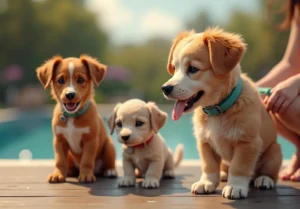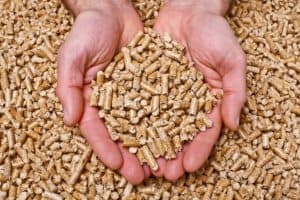Disclosure: We may earn a commission from helpful, relevant links in our content. No cost to you. See our privacy policy.

We all know the drill: Your furball’s gotten a tad too fluffy, and the vet’s given you “the talk” about weight management. Suddenly, you’re diving into the world of cat nutrition, feeling more perplexed than a cat chasing its own shadow.
In this blog post, we’re going to cut through the clutter and give you the straightforward scoop on the best dry cat foods for your feline friend’s weight loss journey. You’re not alone in this – and by the end, you’ll be equipped with knowledge, ready to tackle the pet food aisle with confidence.
Quick Takeaways:
- Choose a weight loss cat food high in protein, low in carbs, and adequately fibrous to support muscle retention and satisfaction.
- Assess your cat’s weight through visual and tactile checks and prioritize consistent vet visits for professional guidance.
- Incorporate portion control, regular play, and possibly puzzle feeders to enhance your cat’s weight loss and mental well-being.
What Makes a Good Weight Loss Cat Food?
When it comes to helping your furry friend shed a few pounds, not all cat food is created equal.
A good weight loss cat food strikes a harmonious balance between high protein content, low carbohydrates, and an adequate amount of fiber. Why? Protein is the building block of muscle, and during a diet, we want our cats to lose fat, not muscle. It also helps keep your cat feeling full and satisfied. Low carbohydrates are key because cats are carnivores by nature; their bodies aren’t designed to handle a carb-heavy diet. Lastly, fiber aids in digestion and further enhances the feeling of satiety.
Don’t forget, while you’re scanning the ingredient list, to look for a food that not only supports weight loss but is also nutritionally balanced to support overall health. This means vitamins, minerals, and fatty acids should be part of the package too. It’s like hitting two birds with one stone – you’re not just helping your cat slim down; you’re boosting their health in the process.
How Can You Tell If Your Cat Is Overweight?
Wondering if your cat has put on a few extra pounds? Here’s how you can tell:
- Visible Waistline: Look at your cat from above. You should see a noticeable indentation – their waist. If it’s more oval-shaped, it might be time to reconsider their diet.
- Feeling for Ribs: When you gently run your hands along your cat’s sides, you should be able to feel their ribs without pressing hard. If not, the extra padding might be hiding those ribs from you.
- Vet Check-ups: Routine visits to the vet are crucial. They can provide a professional and comprehensive assessment of your cat’s weight health. In fact, the Association for Pet Obesity Prevention provides valuable resources and tips for managing pet weight.
Recognizing that your cat is overweight is the first step to getting them back on track to a healthier weight and lifestyle.
What Can You Do to Help Your Cat Lose Weight?
Simply changing your cat’s food to a weight loss formula isn’t a magic solution. Weight management is a multifaceted approach. Here are some hands-on strategies you can implement:
- Portion Control: Measure your cat’s food portions based on the weight loss cat food instructions and your vet’s recommendations. Overfeeding is a common mistake even with the healthiest of foods.
- Play and Exercise: Engage your cat in daily play sessions. Utilize toys that stimulate their predatory instincts, like laser pointers or feather wands. Exercise is essential for burning calories and improving overall health.
- Consistency and Patience: Remember, healthy weight loss doesn’t happen overnight. Stay consistent with the diet and exercise routine, adjusting as necessary under your vet’s guidance.
And here’s a unique tip that might not be at the forefront of every cat owner’s mind: Consider feeding your cat from a puzzle feeder. These innovative devices make your cat work a bit for their food, mimicking the hunt in the wild, which not only slows down their eating but also provides mental stimulation and physical activity. This minor adjustment can have a significant impact on weight management.
By combining the right food with the appropriate care strategies, you’re setting your cat on a path to a healthier, more active lifestyle. Remember, every cat is unique, so what works for one may not work for another. Always consult with your vet before making any significant changes to your cat’s diet or lifestyle to ensure you’re making the best choice for their individual health needs.
Top Picks for Dry Cat Food for Weight Loss
When it comes to helping our feline friends shed a few pounds, the search for the perfect dry cat food can feel a bit overwhelming. But fear not! We’ve pored over the details and nutritional panels to bring you some of the best options out there. Each one has its unique strengths, whether it’s low in calories, high in protein, or packed with fiber to keep your cat feeling fuller, longer.
1. Blue Buffalo Weight Control Natural Adult Dry Cat Food
Key Benefits: Features high-quality protein from real chicken, whole grains, garden veggies, and fruit. It also includes the exclusive LifeSource Bits – a precise blend of antioxidants, vitamins, and minerals. Nutritional Info: Rich in protein and fiber, but low in fat. It also offers a good balance between calories and essential nutrients, making it a balanced diet for weight management.
2. Purina Pro Plan Focus Weight Management Formula
Key Benefits: Contains 20% less fat than Purina Pro Plan Savor, made with real chicken as the #1 ingredient. It also supports lean muscle mass during weight loss. Nutritional Info: High in protein to help maintain muscle during weight loss, enhanced with vitamins and minerals to support overall health.
3. Hill’s Science Diet Adult Perfect Weight
Key Benefits: Clinically proven technology for healthy weight loss within 10 weeks. It supports muscle maintenance and long-term weight management. Nutritional Info: Made with natural ingredients, prebiotic fiber for digestive health, and a clinically proven blend of antioxidants, vitamins, and minerals.
Unique Tip: Incorporate Wet Food
Here’s something you might not hear every day: Incorporating a bit of wet food into your cat’s diet can actually support weight loss. Wet food is often less calorie-dense than dry food, can help keep your cat hydrated (important since cats aren’t big drinkers), and can make them feel fuller without consuming excess calories. Consider mixing a small portion of wet food with the dry food you’ve chosen for an optimized weight loss strategy.
Transitioning Your Cat to a New Food
Changing your cat’s diet isn’t something to rush. A slow and steady approach not only minimizes the risk of digestive upsets but also helps ensure your cat accepts the new food. Here’s a simple guide to ease the transition:
- Day 1-3: Start by mixing 75% of the current food with 25% of the new food.
- Day 4-6: Shift the balance to a 50/50 mix.
- Day 7-9: Increase the new food ratio to 75% and decrease the current food to 25%.
- Day 10: You can now switch to 100% new food.
During this process, keep an eye out for any signs of digestive upset or refusal to eat. If your cat seems hesitant, slow down the transition period a bit more. Cats are creatures of habit, and some may need a little extra time to adjust.
Tips for Smooth Transition:
- Consistency is Key: Try to serve meals at the same time each day. Consistency can help your cat adjust more quickly.
- Patience and Praise: Some cats might be more stubborn than others. Offer lots of encouragement and maybe even a little praise or extra playtime after they’ve eaten.
Remember, the goal of switching to a weight management cat food isn’t just about losing weight but improving your cat’s overall health and increasing their quality of life. With the right food choice and a bit of patience during the transition, you can help your cat achieve a healthier weight and a happier life.
Alex, a passionate animal lover, has experience in training and understanding animal behavior. As a proud pet parent to two dogs and three cats, he founded AnimalReport.net to share insights from animal experts and expand his knowledge of the animal kingdom.




